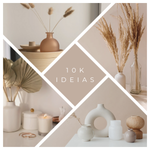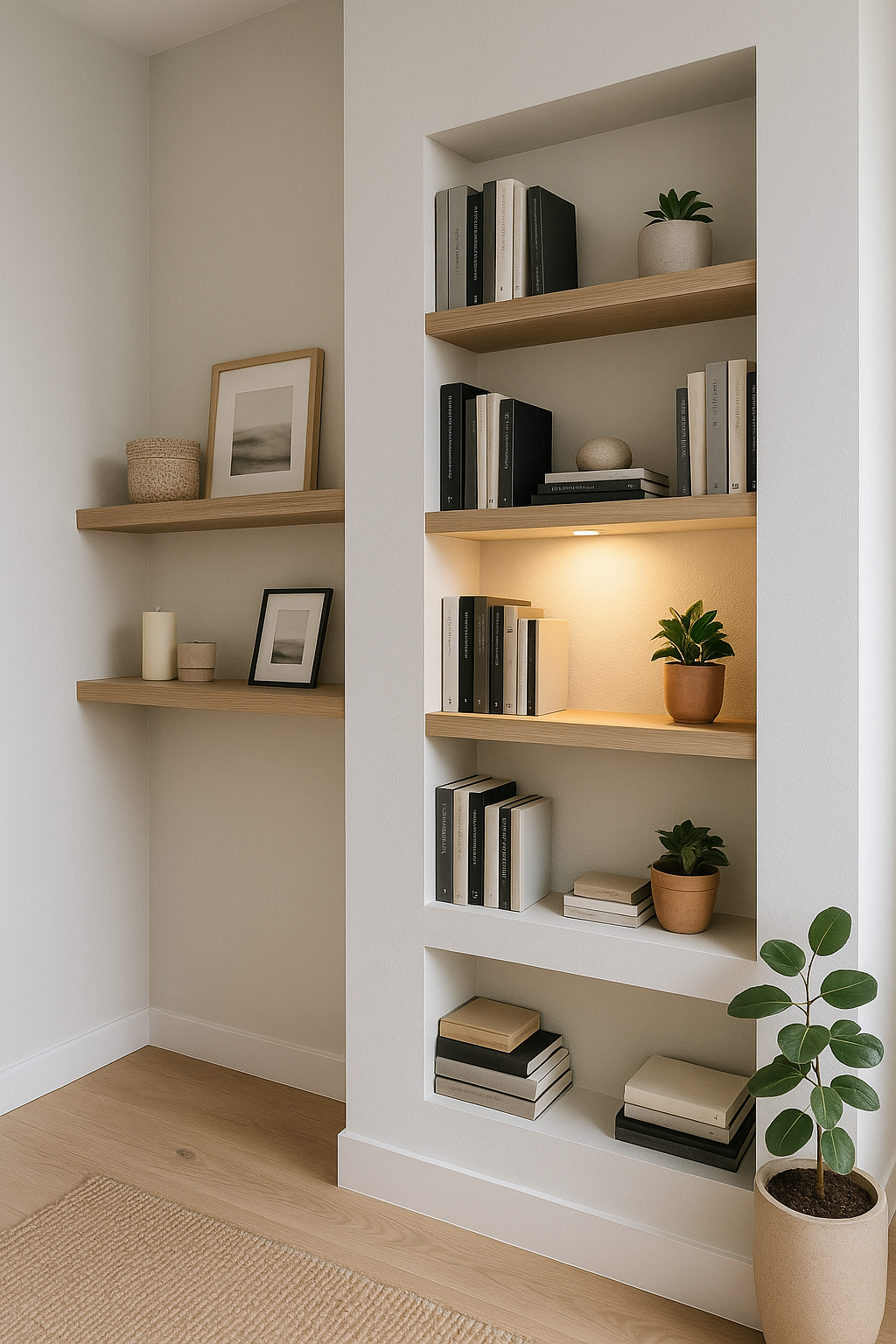In a small apartment, every square meter counts. Making the most of vertical surfaces and recessed areas can transform a cramped space into a well-organized and stylish home. Shelves and niches offer a functional and aesthetic solution for storage and display, helping you keep your space tidy while showcasing your personality. This article explores how to use shelves and niches creatively in tight spaces, offering ideas, practical tips, and design inspiration.
Why Shelves and Niches Are Ideal for Small Spaces
When you live in a compact home, traditional storage like large cabinets or bulky furniture can overwhelm the room. Shelves and niches, by contrast, maximize wall space without taking up valuable floor area. They’re versatile, customizable, and can adapt to almost any room or style.
Benefits include:
- Freeing up floor space
- Creating visual interest
- Offering flexible storage and decor options
- Helping define different areas in open-plan layouts
- Adding resale value through built-in elements
1. Open Shelving vs. Closed Storage One of the first decisions to make is whether to use open shelves or closed cabinets.
- Open Shelves: Best for displaying books, plants, decor, and frequently used items. They keep the room feeling light and open.
- Closed Cabinets with Niches: Great for hiding clutter while maintaining a built-in look. Ideal for bathrooms, kitchens, and bedrooms.
In many cases, combining both open and closed elements provides the best of both worlds.
2. Where to Use Shelves and Niches in Small Apartments
Living Room
- Floating shelves above the sofa: Use them to display art, books, or small plants.
- TV wall niches: Recessed spaces around or below the TV can house consoles, speakers, and books.
- Corner shelves: Ideal for awkward areas that usually go unused.
Bedroom
- Built-in headboard niches: A stylish alternative to nightstands.
- Floating nightstands with hidden drawers: Sleek and functional.
- Wall-to-wall shelving above the bed: Offers extra storage without cramping the space.
Kitchen
- Open shelves above the counter: Perfect for displaying dishes, glass jars, and plants.
- Built-in spice racks or appliance niches: Keeps essentials handy while saving counter space.
Bathroom
- Shower wall niches: Store shampoo and soap without hanging baskets.
- Floating shelves above the toilet: Use baskets or bins for organization.
- Medicine cabinet niches: Blend seamlessly into the wall for a cleaner look.
Hallways and Entryways
- Narrow floating shelves or cubbies: A place for keys, mail, or bags.
- Vertical niches for umbrellas or shoes: Keeps the entry tidy and stylish.
Home Office
- Desk wall shelving: Organize supplies, books, and decorative pieces.
- Hidden niches with sliding doors: Great for papers or tech equipment.
3. Materials and Style Considerations
Materials
- Wood: Classic, warm, and versatile. Use light tones to keep the space feeling airy.
- Metal: Sleek, industrial, and durable. Great for modern or minimalist decor.
- Glass: Reflective and light-enhancing. Ideal for smaller or darker spaces.
- Built-in plaster or drywall niches: Seamlessly integrated into the architecture.
Style Tips
- Match materials with your interior theme: rustic, minimalist, industrial, boho, or Scandinavian.
- Keep a consistent color palette for visual harmony.
- Consider contrast: dark shelves on light walls can create a striking look.
- Use brackets or hardware as design accents if exposed.
4. Smart Shelf Styling
A cluttered shelf can make a small apartment feel even tighter. Use these styling tips to keep things balanced:
- Use the rule of thirds: Divide shelves into thirds and vary the content in each section (e.g., books, decor, plants).
- Group in odd numbers: Three or five objects create more natural visual flow.
- Vary height and texture: Mix tall and short objects, combine ceramics with wood or glass.
- Leave empty space: Negative space is essential for breathing room and minimalism.
5. Storage Niches with Hidden UtilityNiches don’t always need to be visible. They can serve essential functions while staying out of sight:
- Behind doors: Recessed shelving inside closets or pantry doors can store shoes or supplies.
- Above door frames: A shelf placed high on the wall adds subtle storage for rarely used items.
- Recessed desks: Perfect for studio apartments, a pull-down or pull-out niche can become a compact workstation.
6. Built-In Niches as Architectural Features
Niches can also enhance the architectural value of your apartment:
- Accent wall niches with lighting: Highlight art pieces or sculptures.
- Arched wall niches: Add a Mediterranean or vintage charm.
- Wall-to-wall bookcases: Serve as both a visual statement and a functional solution.
If you’re renting, temporary options like self-adhesive shelves or modular units can replicate the look without permanent changes.
7. Budget-Friendly DIY Solutions
You don’t need a custom renovation to enjoy the benefits of shelves and niches. Try:
- Modular cube shelves: Stack them vertically to create custom combinations.
- IKEA hacks: Use affordable furniture components to build floating shelf walls or built-in-style niches.
- Tension rods and hanging baskets: A renter-friendly way to create vertical storage in closets or kitchens.
- Corner brackets and salvaged wood: Create rustic DIY floating shelves on a tight budget.
8. Safety and Practicality
Especially in small spaces:
- Ensure shelves are securely anchored into studs or use wall anchors for safety.
- Don’t overload shelves—check the maximum weight capacity.
- Place heavier items on lower shelves and lighter decor on top.
- Avoid installing shelves too high to access comfortably.
For homes with children or pets, consider rounded corners and higher placement for fragile objects.
9. Maximizing Storage While Enhancing Design
Shelves and niches aren’t just about utility—they’re design elements that help express your style and elevate your home’s atmosphere. Some ideas to balance both:
- Mix books with personal mementos, such as framed photos or travel souvenirs.
- Use baskets or boxes on lower shelves to hide less attractive necessities.
- Integrate LED lighting inside niches to create ambient lighting and highlight your décor.
10. When to Go Custom
In very small apartments, investing in custom built-ins may be worth the cost. Professionals can:
- Design around structural quirks (beams, radiators, odd walls)
- Integrate lighting and wiring
- Optimize awkward layouts with tailored solutions
- Increase resale value through elegant, functional installations
If you plan to stay long-term or want to make the most of every inch, custom work is a smart investment.
Whether you’re working with bare walls, awkward corners, or tight hallways, shelves and niches offer a world of opportunity. They combine function with beauty, creating a sense of spaciousness without adding bulk. By selecting the right materials, keeping your styling intentional, and thinking vertically, you can transform any tight space into an efficient and attractive part of your home.
Would you like me to generate an image now for this article, or should I begin writing the next one: “Home Office Inspiration in 40m² Apartments”?

